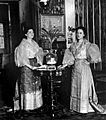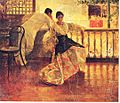Filipinos facts for kids

|
|
| Total population | |
|---|---|
| c. 100 million (c. 11–12 million in Filipino diaspora) |
|
| Regions with significant populations | |
| 3,416,840 | |
| 1,020,000 | |
| 837,130 | |
| 679,819 | |
| 325,089 | |
| 260,553 | |
| 232,386 | |
| 195,558 | |
| 175,000 | |
| 167,859 | |
| 130,810 | |
| 115,362 | |
| 112,000 | |
| 108,520 | |
| 63,464 | |
| 40,347 | |
| 31,000 | |
| 25,000 | |
| 20,937 | |
| 20,589 | |
| 17,574 | |
| 14,544 | |
| 13,000 | |
| 12,791 | |
| 12,474 | |
| 12,262 | |
| 12,254 | |
| 10,000 | |
| 7,000 | |
| 7,000 | |
| 6,500 | |
| 5,665 | |
| 5,500 | |
| 5,000 | |
| 4,800 | |
| 4,500 | |
| 2,114 | |
| 3,000 | |
| 2,900 | |
| Languages | |
| Primarily Filipino, English, and other languages of the Philippines | |
| Religion | |
| Predominantly Roman Catholicism Minority others are:
|
|
| Related ethnic groups | |
| Austronesian peoples | |
Filipinos are the people who come from the Philippines, a country made up of many islands in Southeast Asia. They are known for their warm hospitality and rich culture. Most Filipinos speak one of the many native Philippine languages, and many also speak English very well.
Contents
Who are Filipinos?
Filipinos are a diverse group of people. They have a mix of different backgrounds. This includes influences from ancient Austronesian peoples, as well as from Spanish, American, and Chinese cultures. This mix has created a unique and vibrant Filipino identity.
Where Filipinos Live
Most Filipinos live in the Philippines. It is an archipelago with over 7,000 islands. The country is in Southeast Asia, close to the equator. This means it has a tropical climate.
Many Filipinos also live in other countries around the world. This is called the Filipino diaspora. Millions of Filipinos live outside the Philippines. They live in places like the United States, Canada, Saudi Arabia, and the United Arab Emirates. They often work abroad to support their families back home.
Languages Filipinos Speak
The Philippines has many languages. The two official languages are Filipino and English. Filipino is based on Tagalog, a language spoken in the capital, Manila, and nearby areas.
Besides Filipino and English, there are over 180 other languages spoken. Some of the major regional languages include Cebuano, Ilokano, Hiligaynon, and Bikolano. Filipinos often speak their local language at home and use Filipino or English for school and business.
Religion and Beliefs
Most Filipinos are Christian. The largest religion is Roman Catholicism. This was brought to the Philippines by the Spanish. Many Filipinos attend church regularly. Religious festivals are a big part of their culture.
There are also other religions in the Philippines. A smaller group of Filipinos are Muslims. They mostly live in the southern part of the country, especially on the island of Mindanao. Other religions include Protestantism, Buddhism, and traditional folk beliefs.
Filipino Culture
Filipino culture is a colorful blend of different influences. It combines native traditions with Spanish and American customs. This mix can be seen in their food, festivals, and family values.
Family and Community
Family is very important to Filipinos. They often live in close-knit families. Respect for elders is a key value. Children are taught to care for their parents and grandparents. The community also plays a big role in Filipino life. People often help each other out, especially during tough times. This spirit of cooperation is called bayanihan.
Food and Cuisine
Filipino food is delicious and diverse. It often combines sweet, sour, and salty flavors. Popular dishes include adobo, which is meat cooked in vinegar and soy sauce. Another favorite is sinigang, a sour soup with meat and vegetables. Rice is a main part of almost every meal. Filipinos also love desserts like halo-halo, a mix of shaved ice, fruits, and sweet beans.
Festivals and Celebrations
Filipinos love to celebrate! There are many festivals throughout the year. These often combine religious traditions with local customs. The Sinulog Festival in Cebu and the Ati-Atihan Festival in Kalibo are famous for their colorful parades and lively music. Christmas is also a very important holiday. Filipinos celebrate it for a long time, starting as early as September!
A Look at History
The history of the Philippines is long and interesting. It has shaped who Filipinos are today.
Early Beginnings
Long ago, the islands were settled by Austronesian peoples. They traveled by boat from other parts of Asia. They developed their own kingdoms and trade routes. They traded with people from China, India, and other Southeast Asian countries.
Spanish Influence
In the 1500s, the Spanish arrived. They ruled the Philippines for over 300 years. During this time, many Filipinos became Christian. Spanish words also became part of the local languages. Many old churches and buildings from this time can still be seen today.
American Period
After the Spanish, the Americans took control in the late 1800s. They introduced English education and new ways of government. The Philippines gained its independence from the United States in 1946.
Modern Philippines
Today, the Philippines is a republic. Filipinos are proud of their heritage and their journey to independence. They continue to blend their rich history with modern life.
Images for kids
-
Economic Life in Spanish Colonial Philippines, with Native and Sangley Chinese traders
-
The Urdaneta Tornaviaje Route of the Manila-Acapulco Galleon Trade, connecting the Philippines to the Americas
-
Global Trade Routes of the Spanish and Portuguese Empire
-
Leaders of the reform movement in Spain: left to right: José Rizal, Marcelo H. del Pilar and Mariano Ponce (c. 1890)
-
Filipina women in Filipiniana dress, (Manila, 1899).
-
Marcelo Azcárraga Palmero, the only Spanish prime minister of mestizo (Filipino) descent
-
Manuel L. Quezon was the Philippine President during the Commonwealth era.
-
Migration of the Austronesian peoples and their languages.
-
Spectators at the annual Philippine Independence Day Parade on Madison Avenue in Manhattan, New York City
-
Tagalog maharlika, c.1590 Boxer Codex
-
Tagalog maginoo, c.1590 Boxer Codex
-
Visayan kadatuan, c.1590 Boxer Codex
-
Native commoner women (likely Muslims in Manila at the time), c.1590 Boxer Codex
-
Visayan timawa, c.1590 Boxer Codex
-
Visayan pintados (tattooed), c. 1590 Boxer Codex
-
Visayan uripon (slaves), c. 1590 Boxer Codex
-
Binukot from Visayas, c. 1590 Boxer Codex
-
Sangley Pancit vendor by José Honorato Lozano
-
Filipino couple in Tampuhan by Juan Luna
See also
 In Spanish: Pueblo filipino para niños
In Spanish: Pueblo filipino para niños



































